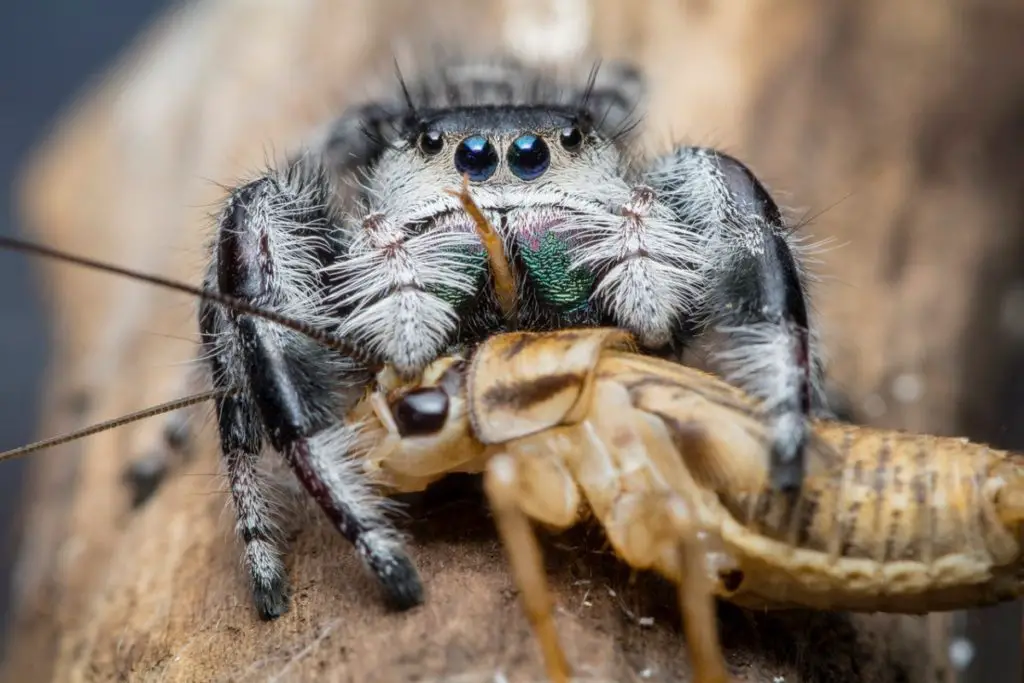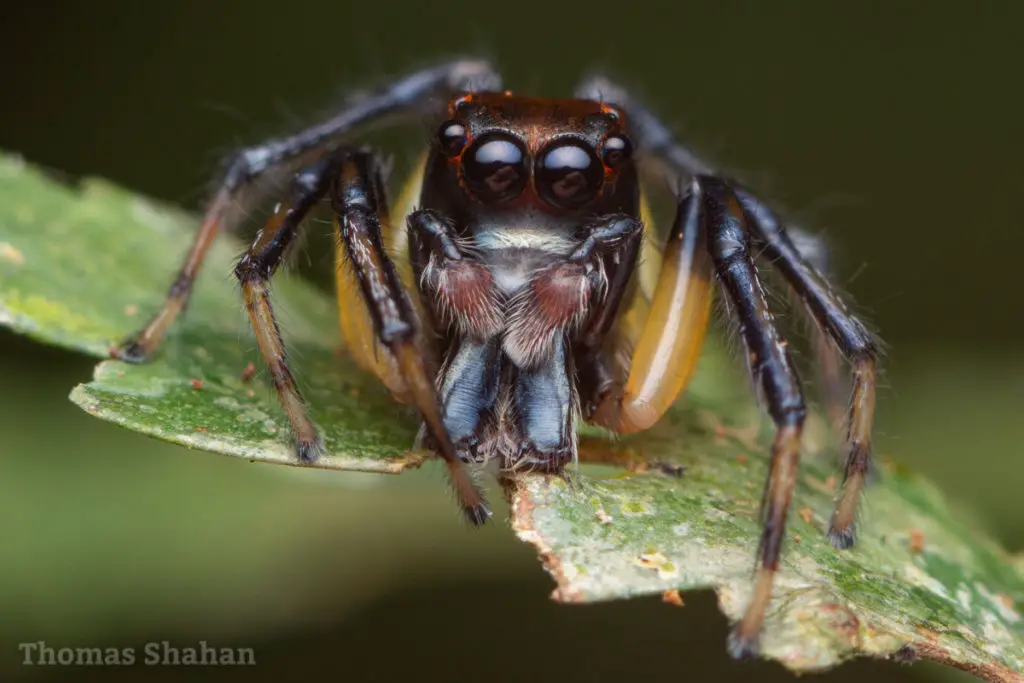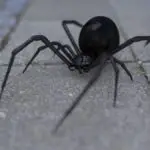Jumping spiders are little creatures that are so common that we may encounter them inside our house. They make excellent pets as they are beautiful, cute, and easy to take care of. In this article, I will teach you how to take care of your jumping spider.
Keep the jumping spider in an escape proof, ventilated tank. Decorate the tank to give it more surfaces to explore. Feed the spider twice a week with crickets or house flies and mist the enclosure weekly. Juveniles need more frequent feeding. Lighting is required since they are diurnal.
Let’s dive into more details about jumping spiders and how to take care of them.
Introduction to the Jumping Spiders
Jumping spiders are a group of spiders under the family Salticidae. They can be found worldwide, with more than 6000 species. As their name suggests, they are good at jumping.
The sizes of jumping spiders vary by species. They are generally small in size, with the largest species close to 1” in body length.
Jumping spiders are notable for the pair of large eyes on their face. Those are called the anterior median eyes, which are used by the jumping spider to look for prey.
The jumping spiders have another 3 pairs of smaller eyes, which means they have a total of 8 eyes. The extra eyes are used to help them cover wider angles, and judge the distance between jumps.
There is a wide variety of colors and patterns on the jumping spiders, which is not surprising given the huge number of species. Many of them are good at the art of mimicry, resulting in so many variations.

Some jumping spiders have colors that resemble dangerous creatures to ward off their predators. For example, the coloration of a Phidippus apacheanus resembles that of a velvet ant wasp which can inflict painful sting.
Others have colors similar to their natural environment so that they can blend into the background easily without being noticed. Paramarpissa spp. in Mexico and US for example, is a group of jumping spiders mastering the art of disguising on tree barks.
And yet some of the jumping spiders pretend to be creatures which their predators are not interested in. For instance, the Peckhamia spp.resemble ants, which are usually left alone by most predators.
The lifespan of jumping spiders varies depending on the species. There are species that can live up to 3 years. But generally, their lifespan is about a year.
Getting Jumping Spiders
Jumping spiders are rather common and you might be able to find them in your house. You can easily catch them using a small deli cup. In fact, as I was writing this article, a jumping spider appeared behind my monitor!
One issue with catching spiders is species identification. It is not easy to identify them. You can refer to this website to see what are the common spiders available in your countries or states, and hopefully that will give you some clues on what species you have caught. You can also seek advice if you need help identifying the species of spider you caught.
The second issue is age determination. This is not important for jumping spiders in my opinion since they are quite common. Unless you plan to breed it or invest some money for a good enclosure, the age really doesn’t matter.
Of course, you can buy jumping spiders from breeders. Some breeders rear exotic species with unique coloration, which is worth buying. Those breeders should be able to tell you the species you buy and the age of the spiders.
You can easily search for jumping spider breeders from social media platforms or through a Google search. Make sure you read consumer reviews before buying.
Enclosure for Jumping Spider
While the jumping spiders are small in size, they would appreciate a large enough enclosure for them to explore.
Prepare an escape-proof enclosure with vents. You can use any transparent plastic jar and make holes on the jar. The holes should be small enough so the spider can’t escape.
Lay some coir at the bottom of the enclosure. You can also use paper towels instead of coir. This will help to absorb litters produced by the spider and reduce the need to clean the enclosure.
You can decorate the enclosure with branches, stones, driftwood etc. That will also provide your spider a shelter to hide.
Don’t house more than a jumping spider in the same container because they might cannibalize each other. Note that I use the word “might” because it depends on whether the spiders have enough space and food.
Microclimates for Jumping Spiders
Given there are 6000 over species of jumping spiders around the world, their requirement to microhabitat can be very different.
Generally, your jumping spider will be able to survive room temperature, which is around 68 – 77 °F (20 – 25 °C). If you are keeping exotic species from warmer regions, use a heat mat to warm up your spider when the climate turns colder. Make sure you don’t overheat your spider.
Jumping spiders are diurnal, which means they are active during the daytime. You can place them somewhere bright but don’t put them under direct sunlight.
You can use an LED light and set a timer to mimic the daylight hour. Just make sure there is somewhere for the jumping spider to hide if it needs a rest.
Quenching the Thirst
Mist the enclosure weekly or more if you are keeping tropical species. That will keep the enclosure moist. The jumping spider can also drink the water droplets from the mist.
Alternatively, you can put a small water dish into the enclosure. Add some pebbles to the water dish so that the spider or any feeder insects introduced have a way to escape from drowning.
How to Feed the Jumping Spider

Feed the jumping spider twice a week with crickets or house flies not more than 1.5 times the spider’s body size.
Jumping spiders are agile hunters. They visually locate their prey and hence some level of lighting is required. Once they locate their prey, they stalk the prey, move themselves to higher ground if required, and pounce on their prey.
Jumping spiders are known to attack prey larger than themselves. However, I advise you not to give them feeder insects too big. Something 1.5 times the size of the jumping spider is the maximum size you can try. After all, you don’t want your spider to become the prey instead.
Other than crickets and house flies, you can also feed your jumping spider with roaches. You can easily buy those feeder insects from exotic pet stores. Both crickets and roaches can be easily maintained at home to supply your jumping spider consistently.
If you need to be away for a week or two, just leave some fly pupae in the enclosure. The flies will emerge within a week. You don’t have to worry about starving your jumping spider and at the same time, the flies can’t hurt your spider. You can add a small bottle of 10% syrup water covered with a cotton wick so that the house flies can survive long enough until it is eaten by the spider.
Molting
Like other spiders, jumping spiders grow by molting. Depending on species and sex, jumping spiders molt 6-9 times in their entire life.
When molting, the jumping spiders spin webs and hide themselves in the web. When you notice that, stop giving your spider food and don’t disturb your spider. Continue to mist the enclosure as usual.
The whole molting process can take up to 2 weeks depending on species and age of the spider. The spiders have soft skin immediately after molting. It takes 2-3 days before the newly formed skin is fully hardened. You should start feeding and/or handling your jumping spider only after its skin has hardened.
Cleaning the Enclosure
Clean the enclosure and change the substrates once every 2-3 months. If you laid paper towels in the enclosure, change the paper towel when it looks dirty.
Sometimes, there will be leftover limbs of the feeder insects. Just remove it whenever you see it. Otherwise, it will rot, grow molds and attract pests.
How to Breed Jumping Spiders?
Breeding jumping spiders is something interesting and worth experimenting. Many jumping spider species don’t produce a hell lot of eggs like some other spiders. Phidippus californicus, for instance, produces around 30-40 eggs each time. That is quite a manageable quantity.
To breed jumping spiders, you need adult spiders of opposite sex from the same species.
Let’s start with species. Only the spiders of the same species can produce viable offspring. A spider will not show any interest in courting another spider if they don’t belong to the same species!
If you buy your jumping spiders from a reputable source, the seller should be able to tell you the correct species. If you caught the spiders by yourself, you need to identify them. Here’s a website that might be useful to help you identify your spiders.
Obviously, you need a male and a female spider to breed. Generally, male spiders are smaller than their female counterparts. Certain species have clear distinctions between adult male and female. For example, a typical adult female of P. regius has an amber or gray body while the male has a black body.
Another clue that you can refer to is by looking at the pedipalps of the adult spider. The tip of a male jumping spider’s pedipalps is slightly swollen. It might not be obvious for some species, and this is usually only visible in adult but not juvenile spiders.
Note: Pedipalps are the 2 feelers located before the first pair of legs.

Mating
An adult male jumping spider will build a sperm web where he deposits his sperm onto the web. He then picks up the sperms using his emboli (the swollen tip) on his pedipalps, and he is ready to mate.
The male jumping spider will dance to attract the female spider. Sometimes he had to chase after her to mate.
With her consent, the male jumping spider will put an embolus into the female’s genital to deliver the sperm. After that he will insert the other embolus. Once done, the male jumping spider will either retreat or stay with the female spider to ward off any other male spider.
Eggs Laying
Soon after mating, the female jumping spider will lay eggs at her nest. The eggs hatch within a month.
If given enough food, the mother will lay a few more batches of eggs. If you don’t want to handle that many eggs, remove and destroy them, or give them to other hobbyists.
Taking Care of the Jumping Spider Brood
Feed the newborns with fruit flies or pinhead crickets depending on their size. You can feed them twice a week. The size of the feeder insects should not be larger than the young spiderlings because they are still weak.
If your spiderlings are too small, they could be drowned by water mist. So, instead of misting, prepare a wet paper towel or cotton wool as the source of water.
The young spiderling can be kept with the mother for at least a month before you need to separate them. Some level of cannibalism is bound to happen, and can be minimized by giving your spiders enough food, space, and hiding places.
Recommended Supplies
Here are my recommended supplies that you can consider for keeping jumping spiders. Note that I get a small commission when you buy the items through the links in this page. This helps me maintain the site without incurring additional costs to you.
Handling Jumping Spider
Jumping spiders can be easily handled by bare hands. They rarely bite. Even if they bite, their venom is too weak to cause serious harm unless you are allergic, just like how some people are allergic to peanuts.
Jumping spiders always play safe. They use silk to create a life line for them as they explore the surroundings. Hence, you don’t have to worry about them falling from height.
What if I Got Bitten by the Jumping Spider?
In any case if you got bitten by the jumping spider, wash and clean your wound. There might be a small weal developed from the wound and typically, that’s all. If you experience any other symptoms such as nausea, increased heart rate, difficulties in breathing etc., please seek medical attention immediately.
While the venom from a jumping spider is mild, the bite itself can be very painful.
Final Words
I hope you find this guide useful. Do check out my other guides on tarantulas and black widow spiders. Those are the other group of spiders that can be kept as pets.


